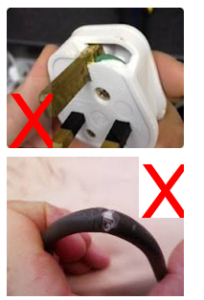
Electricity at Work
Legal Stuff
Each year, there are approximately 1,000 electrical accidents, some of which result in fatalities. 5% of all fatal work-place injuries are caused by electricity.
There are specific Electricity at Work Regulations requiring us to ensure that all electrical equipment is properly installed and maintained so that there are no electrical hazards in the workplace. The regulations apply to both fixed and portable equipment whether it operates at high or low voltages and wherever it is used.
The regulations do not go into specific detail about the safety of installations because there are European Standards which are set out in British and Irish Standards and are generally referred to as the Wiring Regulations. These are regularly updated to reflect changes in technology and equipment.
Information
Electricity is a killer, make no mistake about that! Not only that, it can also cause serious burns and fibrillation of the heart muscles. A significant electrical shock may cause other injury, by throwing you off a ladder or scaffold or causing damage to internal organs.
It is not just people using electricity who are at risk; poor electrical installations and faulty electrical appliances can lead to fires causing significant property damage and could lead to fire related deaths or injuries.
Most of these incidents can be avoided by keeping electrical installations and portable equipment well maintained.
Understanding how electrical equipment is designed to be safe helps us to spot when things are wrong and therefore become dangerous.
Safe Use of Electrical Equipment
- Fuses – cut off the power supply if current exceeds a limit. It is essential that correctly rated fuses are used.
- Earth conductor – the earth wire acts as a conductor to the ground if equipment becomes live for any reason.
- Isolators – cut power off from all supply circuits so that fixed equipment can be maintained; some isolators can be locked in the off position. Make sure that portable equipment is unplugged before it is maintained.
- Reduced voltage (usually 110 volts or battery powered) – lessens the severity of any shock received; generally used on construction sites for portable tools and equipment, but of benefit in other situations. Using 110-volt equipment only reduces risk it does not eliminate risk.
- Residual current device (RCD) – may be a plug-in portable device or part of a fixed installation; isolates the supply to electrical equipment if it detects an earth current fault. RCDs offer a higher level of protection than fuses or circuit breakers.
- Double insulation – provides extra insulation and protection against shock; double insulated equipment does not need to be earthed.
Inspection And Testing
Fixed Electrical Installations – mains wiring, socket, distribution boards, lighting, etc:
- Installation must be installed to standards and maintained.
- Visual inspection to be carried out regularly.
- Formal testing–by competent person e.g. electrician.
- Frequency of testing and inspection varies for different types of installation.
- Records must be kept.
Portable Electrical Appliances – anything moveable with a plug, e.g. kettle, till, computer, pressure-washer, welder, grinder, drill:
- Equipment must be well maintained by competent staff.
- Visual inspection undertaken regularly – this is the best way of detecting faults.
- Formal portable appliance testing – frequency depends on many factors, including age of equipment, how often it is used, type of equipment, where it is used, etc. It can be more than 1 year; it may be less.
- Important to keep records or mark equipment to show it has been tested.
What You Need to Do

- Make sure you have been trained and are competent to use electrical work-equipment.
- Familiarise yourself with controls, emergency stop buttons and isolators.
- Check that portable electrical equipment has available inspection, test, and maintenance information; this may be on the equipment or on a filed report.
- Check the equipment and power lead every day before use. If you can see damaged insulation or sheathing, isolate the equipment and report it immediately.
- Make sure the cable is properly gripped by the plug, with no burn marks, cracks, or bent connector pins.
- Cables and leads should be in good condition—no kinks, strain, or damage.
- Inspect for any signs of damage like overheating, exposed wires, or brittle insulation. Avoid taped-up repairs.
- Report faulty equipment to your line manager and remove it from use.
- Always use and test provided Residual Current Devices (RCDs) daily, but don’t rely on them to prevent electric shock entirely.
- Use only purpose-designed electrical equipment in risky environments like wet areas or flammable atmospheres.
- Report any incidents or injuries promptly.
- Do not try to repair equipment yourself unless trained, authorised, and competent.
Remember to always check equipment before use and if you spot any damage isolate it, do not use it, and report the fault.
Discussion Questions
Q: If you see damage to a piece of electrical equipment, what must you do?
A: Take it out of use, report it to your manager so that it can be repaired and replaced.
Q: What should you do if the power supply to equipment you are using trips out?
A: There will be a reason for the equipment tripping out, do not be tempted to clear the fault and continue to use the equipment. Treat it as damaged.
Q: Why should power tools never be lifted or pulled by the cable?
A: Because it is possible that the cables may be pulled out of place, the earth or neutral wires could contact the live supply and make the whole appliance live and a significant hazard.